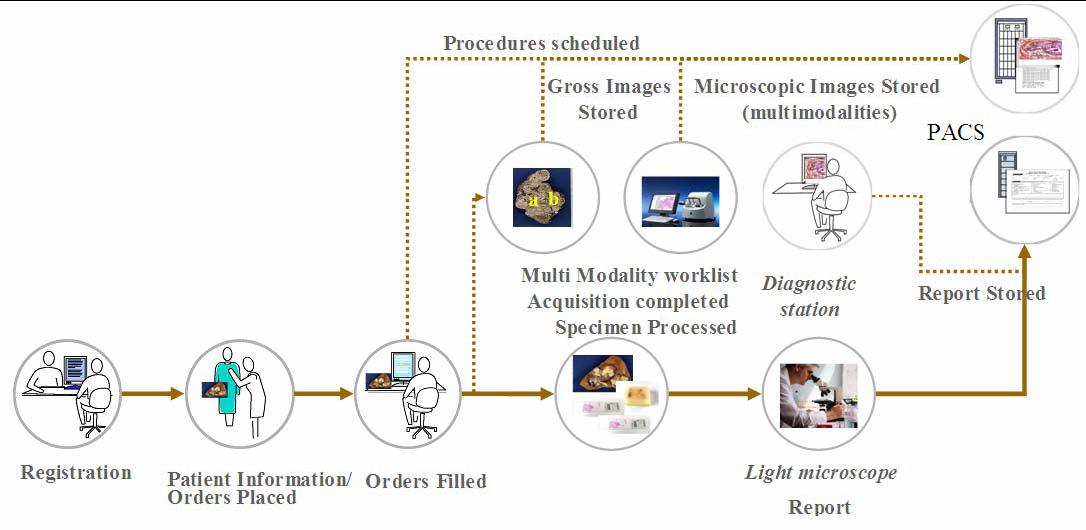Difference between revisions of "Anatomic Pathology Workflow"
(New page: '''Pathology Workflow (PWF)''' integrates the pathology department in the healthcare institution, and covers these specialties: surgical pathology, clinical autopsy, cytopathology. __TOC...) |
|||
| Line 23: | Line 23: | ||
==Details== | ==Details== | ||
| − | The | + | The scope of this profile includes surgical pathology, biopsies pathology, cytopathology, autopsies, and related techniques (immunohistochemistry, molecular pathology, etc). |
'''Use cases:'''<br/> | '''Use cases:'''<br/> | ||
| − | + | This profile supports 5major use cases: | |
| − | * | + | * Use case 1: Surgical pathology – Operative specimen |
| − | * | + | * Use case 2: Surgical pathology – Biopsies |
| − | * | + | * Use case 3: Cytology |
| + | * Use case 4: Autopsy | ||
| + | * Use case 5: Tissue Micro Array (more than one specimen from more than one patient per container) | ||
| − | + | This profile leverages IT Infrastructure profiles [PAM] for sharing up to date patient and encounter data, and [ATNA] and [CT] for security. | |
| − | |||
| − | |||
| − | This profile leverages IT Infrastructure profiles [PAM | ||
| − | |||
| − | |||
| − | |||
==Systems Affected== | ==Systems Affected== | ||
| Line 43: | Line 39: | ||
Systems involved in this profile are: | Systems involved in this profile are: | ||
| − | * | + | * The hospital Clinical Information System |
| − | * | + | * The system of the pathology laboratory |
| − | * | + | * Imaging modalities |
| + | * Multimodalities | ||
| + | |||
'''Actors & Transactions:''' | '''Actors & Transactions:''' | ||
| − | <center>[[Image: | + | <center>[[Image:pwf-actor-transaction.JPG]]</center> |
<br/> | <br/> | ||
Revision as of 05:34, 12 June 2008
Pathology Workflow (PWF) integrates the pathology department in the healthcare institution, and covers these specialties: surgical pathology, clinical autopsy, cytopathology.
Summary
The Pathology Workflow Integration Profile establishes the continuity and integrity of basic pathology data acquired during examinations ordered for an identified inpatient or outpatient. This profile covers three main aspects of the workflow:
- The ordering aspects of the workflow - The PWF profile specifies a number of transactions to maintain the consistency of ordering information and specimen management information.
- The reporting aspects of the workflow - The PWF profile specifies a number of transactions to create and store observations and reports outside the Pathology department and to maintain the consistency of these results.
- The imaging aspects of the workflow - The PWF profile specifies a number of transactions to create and store images and to maintain the consistency of these images. Worklists for image acquisition is generated and can be queried. This Integration Profile also describes evidence creation.

Benefits
Reduces Errors and Enhances Patient Care
- Prevents manual data entry errors by ensuring that each piece of information is entered only once, by the person closest to the source of this information, and from there, made available in due time to any system who needs it.
Details
The scope of this profile includes surgical pathology, biopsies pathology, cytopathology, autopsies, and related techniques (immunohistochemistry, molecular pathology, etc).
Use cases:
This profile supports 5major use cases:
- Use case 1: Surgical pathology – Operative specimen
- Use case 2: Surgical pathology – Biopsies
- Use case 3: Cytology
- Use case 4: Autopsy
- Use case 5: Tissue Micro Array (more than one specimen from more than one patient per container)
This profile leverages IT Infrastructure profiles [PAM] for sharing up to date patient and encounter data, and [ATNA] and [CT] for security.
Systems Affected
Systems involved in this profile are:
- The hospital Clinical Information System
- The system of the pathology laboratory
- Imaging modalities
- Multimodalities
Actors & Transactions:
Specification
Profile Status: Trial Implementation
Documents: IHE Laboratory Technical Framework:
Underlying Standards:
See Also
Related Profiles
- Integration Profiles LTW depends on
- Patient Administration Management (PAM) and/or Patient Demographics Query (PDQ) provide accurate patient demographics used by LTW: An application implementing one of the Actors Order Placer, Order Result Tracker, Order Filler shall also implement the Actors Patient Demographics Consumer and Patient Encounter Consumer from either PAM or PDQ Profile or both.
- Audit_Trail_and_Node_Authentication (ATNA) to audit creation and access to patient data during LTW. An application implementing one of the Actors Order Placer, Order Result Tracker, Order Filler shall also implement the Actor Secure Node from ATNA.
- Consistent_Time (CT) to ensure timestamps in LTW data and audit messages are accurate.
- Integration Profiles depending upon LTW
- Laboratory_Device_Automation (LDA) from the Laboratory Technical Framework: The Actor Automation Manager from the LDA Profile must also be an Automation Manager in the LTW Profile.
- Laboratory_Point_Of_Care_Testing (LPOCT) from the Laboratory Technical Framework: The Actor Order Filler from the Laboratory LPOCT Profile must also be an Order Filler in the LTW Profile.
- Laboratory_Barcode_Labeling (LBL) from the Laboratory Technical Framework: The Label Information Provider Actor of the LBL profile shall be grouped with either the Order Filler or the Order Placer from the LTW profile.
Consumer Information
This page is based on the Profile Template